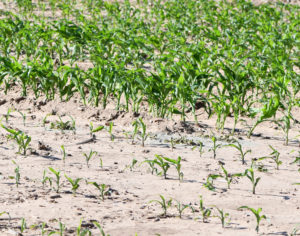Research shows late-planted sorghum, other crops good alternatives to failed cotton
Writer: Kay Ledbetter, 806-677-5608, [email protected]
Contact: Dr. Qingwu Xue, 806-354-5803, [email protected]

AMARILLO – The window for planting cotton may have been closed by too much rain, but a Texas A&M AgriLife Research scientist said past trials show producers could still benefit from all the moisture with dryland grain sorghum or corn or other alternative crops.
“With all this moisture in the ground, producers still have an opportunity to get a crop in the ground and see good yields,” said Dr. Qingwu Xue, AgriLife Research crop physiologist, Amarillo. “Which crop will depend on their particular circumstances in their field.”
Xue said most sorghum is already being managed on limited irrigation or dryland because it is a more drought-tolerant crop. Even when it stopped raining completely in July in 2017 and 2018, dryland sorghum made 50-90 bushels per acre on average when planted in late June, with the help of rains in August and September.
grain sorghum
“This area’s optimal planting date is June for sorghum anyway, because that’s when the chances of rain are the best in most years,” he said.
Sugarcane aphids, however, could be an issue on late-planted sorghum, whether it is for grain or silage, Xue said. Producers need to make sure they select varieties with some resistance and then scout their fields and be prepared to spray.
“The last two years, the sugarcane aphids have arrived in late July and August and that is when the sorghum will be in the bloom stage,” he said. “This is one of the most vulnerable times.”
Xue said in both 2017 and 2018, planting date and hybrid selection had significant effects on sugarcane aphid infestation, grain yield, water use and water-use efficiency. During those years, early May planted sorghum experienced more drought stress and yielded less than late June-planted sorghum.
More mid- to late-season rainfall resulted in higher yields in the later planted sorghum. In 2017, average yield was 25 bushels per acre in early May-planted sorghum and 70 bushels per acre in the late June-planted crop. In 2018, the average yield was 50 bushels per acre in early planted fields and 61 bushels per acre in the late.
For the early planted sorghum, the sugarcane aphid infestation was minimal or none because the sorghum matured before they arrived. However, there were greater sugarcane aphid populations in late-planted sorghum, which might have affected yield.
He said he also has an ongoing late-planted corn study, and, “I know we can push the date to July 1 and still make about 150 bushels per acre in irrigated corn.”

Another potential crop is cowpeas or black-eyed peas, he said. They are very drought tolerant, so make a good option if a producer can get a contract.
“So, we still have windows to plant in, but we may be past most insurance coverage dates for cotton and corn,” Xue said. “Regardless of what crop you are going to grow, the most important thing is getting good soil moisture in the profile, and that shouldn’t be a problem this year.”
A major consideration on what crop to replant will be any herbicides already applied to the field.
“So, you may need to check the herbicide labels or contact an AgriLife Extension agronomist for any replant restrictions and crop selection,” Xue said.
Also, he warned, nitrogen may have been leached out by the heavy rainfall, so more may need to be applied.
More detailed information can be found in the 17th edition of Alternative Crop Options after Failed Cotton and Late-Season Crop Planting for the Texas South Plains, https://tinyurl.com/lateplantingcropalternatives.


